Opening in the summer of 1999, and built right next door to Universal Studios Florida, Islands of Adventure is Universal Orlando’s second theme park. The park, which had been in development for most of the 1990s, opened with lands based on properties like Jurassic Park and Marvel Super Heroes. But, it wasn’t always planned that way.
The original concept for this park would’ve featured lands based on Looney Tunes, DC Comics, and more. So what happened? Let’s dive into the history and ultimate failure of Universal’s Cartoon World. Plus, check out the video version for additional visuals.
Part 1 — Competing with the Mouse
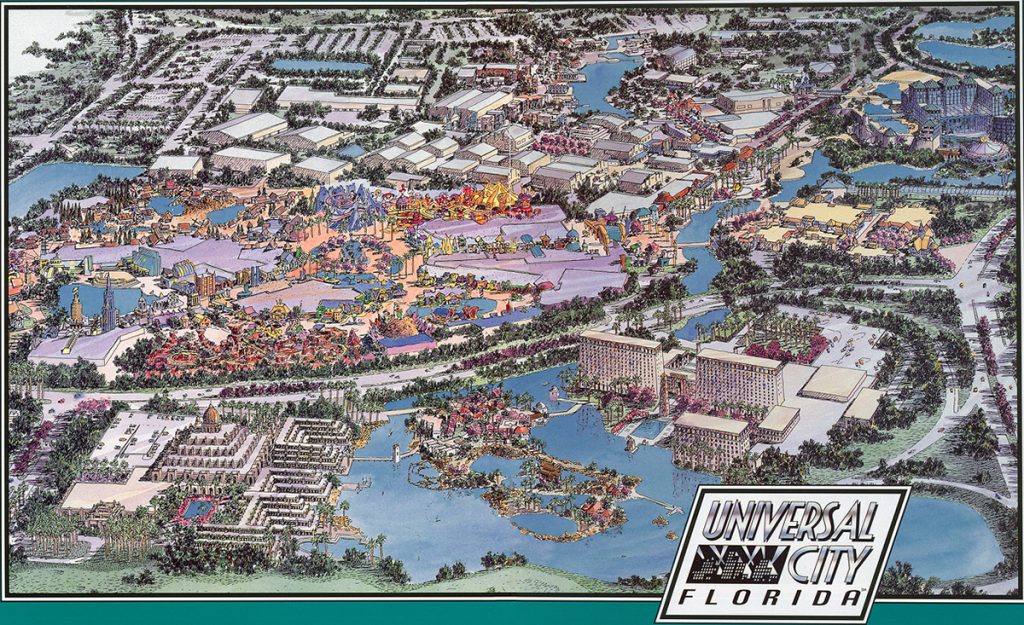
Image: Universal Studios, Source
In 1991, just one year after Universal Studios Florida had opened, Jay Stein, the head of Universal Parks at the time, held a meeting with a executives and a few attraction developers. In this meeting he proposed the concept for a new theme park, one that would not only be the company’s second gate in Orlando, but as he put it, it was “going to be our number one park.”
Referred to at first only as “Project X,” the plan was to move from a niche park and one-day destination, to a much broader audience, capturing more of a family’s Orlando vacation time. Universal wanted to appeal to a younger demographic with this new park. And so, the idea for “Cartoon World” was born.
Universal looked to partner with Warner Bros. for this park. Since they were intending to compete directly with Walt Disney World, most notably the Magic Kingdom Park, Warner’s back catalog of beloved cartoon characters, as well as their ties to the popular film versions of DC Comics, seemed like an easy way to acquire characters that were already well established.
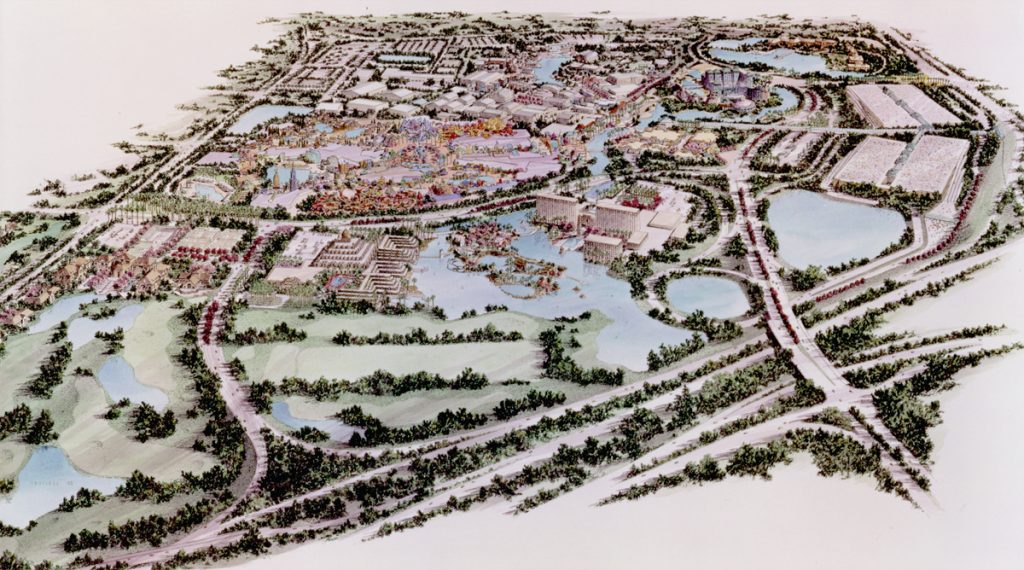
Concept Art for entire resort including Cartoon World, Source
Disney had recently opened their new theme park with MGM, and Universal saw this as their opportunity to partner with another studio in the same way. Plus, as a bonus, Universal figured they would possibly get first pick at some of Warner’s future live-action properties, and be able to incorporate them into their studio parks. Jay Stein also believed it was important to partner with Warner Bros. to prevent them from partnering with another company, or even creating their own parks in the U.S. the future.
To help secure these rights from Warner Bros., Universal tasked several design teams to create pitches for possible rides, shows, and even restaurants using Warner’s characters. These concepts would be used as a sales tool to help convince the studio to sign on the dotted line. Meanwhile, early concept art was also created for what the entire Universal Orlando Resort might look like when the new park was set to open, then scheduled for 1998. In addition to Cartoon World itself, massive parking garages, an entertainment district, and several hotels were conceptualized in this master plan, to be built around the existing Universal Studios Florida park.
Part 2 — Not Reinventing the Wheel
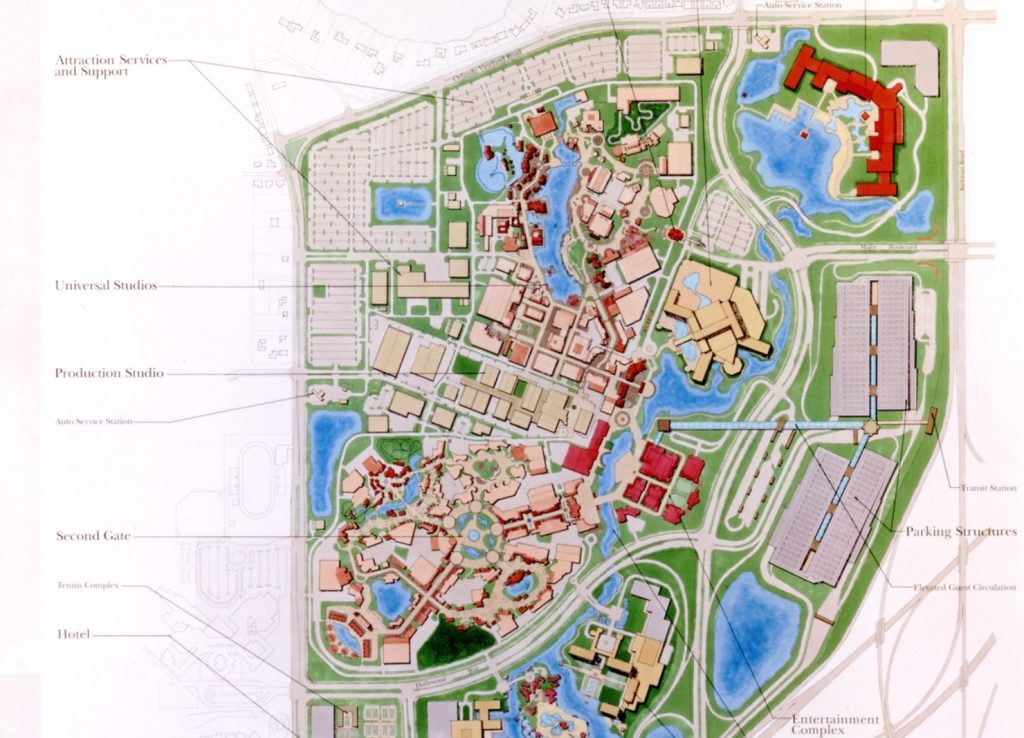
Image: Universal Studios, Source
One way to compete with Disney, was apparently to think like Disney. The very first plans and concepts for the Cartoon World theme park had it designed in a hub and spoke layout. The park was conceived as a colorful combination of lands based on a variety of properties, all branching from a central hub area—not unlike the tried and true designs for Walt’s original Disneyland Park in Anaheim.
Instead of Main Street U.S.A., Cartoon World’s entry road was to be named Comic Strip Lane. Guests would enter through a loading dock to a factory of sorts. This factory would be designed as if it created cartoons, comic strips, and comic books. You might even see cartoon characters clocking in for work in the many windows of the building. Plus, many of the other buildings down the street would be anthropomorphized, with faces, to make it feel like the architecture was itself alive.
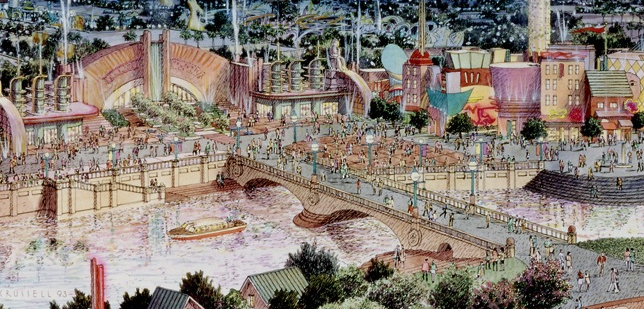
Cartoon World entrance concept, Source
Before entering Cartoon World, we would have to pass through a sort of customs tunnel. Here animatronic cartoon character guards would watch to see what types of real-world items you might be attempting to take into the Cartoon World. After entering the park, Comic Strip Lane would feature the usual entry area gift shops and dining you might see at most parks, as well as a small movie theater that would show cartoons.
This entry land was designed to feature one attraction, the Cartoon World Opera House, featuring the Night of the Opera show. This show would bring together characters from all of the lands of the park under one roof, performing to music by the Carl Stalling Commemorative Cartoon Band, At the end of the street would be a large viewing area for a nightly fireworks show, just like you would find at the Disney castle parks around the world.
Part 3 — The Original Toon Lagoon
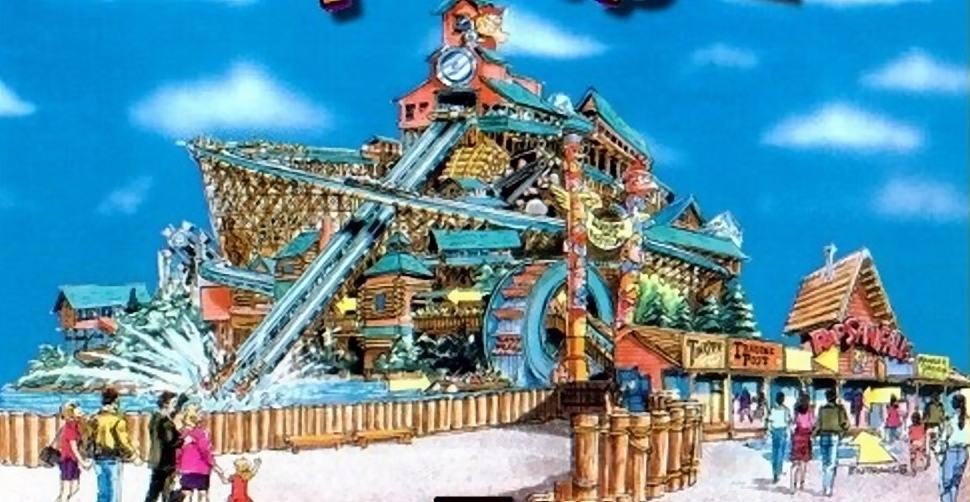
Image: The Goddard Group, Source
While talks with Warner Bros. were going on in the background, Universal was able to secure the theme park rights to the cartoon characters by Jay Ward. This included Rocky and Bullwinkle, Dudley Do-Right, and more. Disney still had the film rights to many of these characters, but Universal securing them for theme parks was a big win for the company. As a result, concepts for attractions based on these characters were some of the first to be designed.
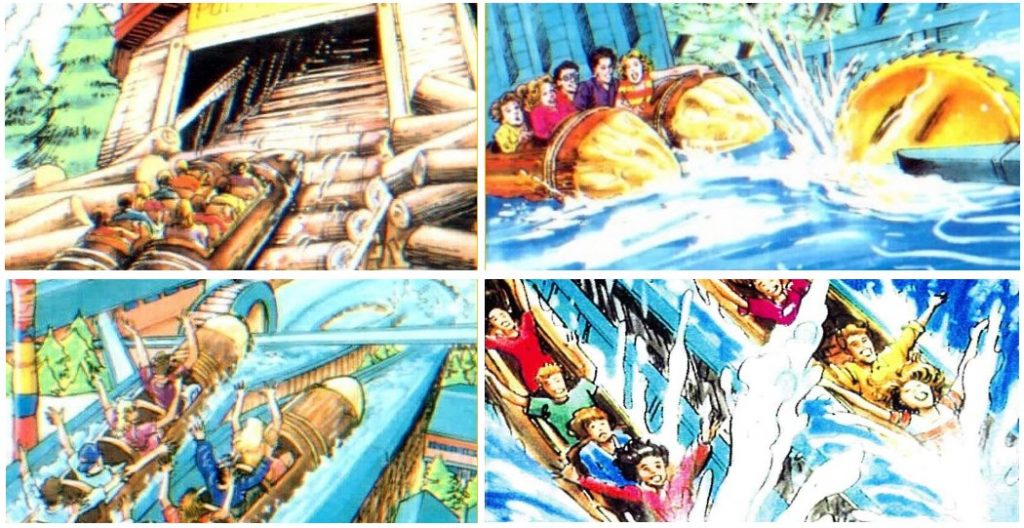
Image: The Goddard Group, Source
The Northwest Mining Camp was going to be a land featuring a ride that was then referred to as “Dudley Do-Right’s Great Northwest Sawmill” flume ride. While we did end up with this ride in the current park—but with a different name—there was one other notable difference for the ride itself from what we got. In the original concept, guests were seated in a double log design, but just before the final drop, a large saw would appear to split the two sections into two individual boats, each falling down their own slide. Even to this day the ride features a double drop design, but the sawmill log split gag never saw the light of day.
Another property that made it from the old plans to the current park was Popeye the Sailor Man. Originally though, Popeye’s Island was to be split into two sections: Sweethaven Village and The Docks. Sweethaven would feature shops, Wimpy’s Burger restaurant, and a dark boat ride called “Popeye’s Adventure.” This indoor attraction would start as a peaceful boat tour around the village, that is until villains kidnap Popeye’s friends, forcing us to go after them.

Image: The Goddard Group, Source
The Docks’ main attraction was to be “Bluto’s Bilge-Rat Barges,” which was touted as “the wildest, wettest, meanest, and maddest river you ever see’d.” Not much from the initial version was changed when it came time to build. To this day it really is the wettest raft ride around. Another notable concept for The Docks was The Roughhouse Cafe, a live dinner show that would’ve been similar to the Hoop-Dee-Doo Musical Revue at Walt Disney World. This variety show featuring sailors performing acrobatics, singing, and dancing would be themed as a shanty made from old boat parts and whatever was lying around.
Additional ideas for things like a Mighty Mouse show, Casper the Friendly Ghost haunted house, and a Mr. Magoo bumper car ride were also considered for these areas early on, but never made it very far in the pitch phase.
Part 4 — Dr. Seuss as Fantasyland
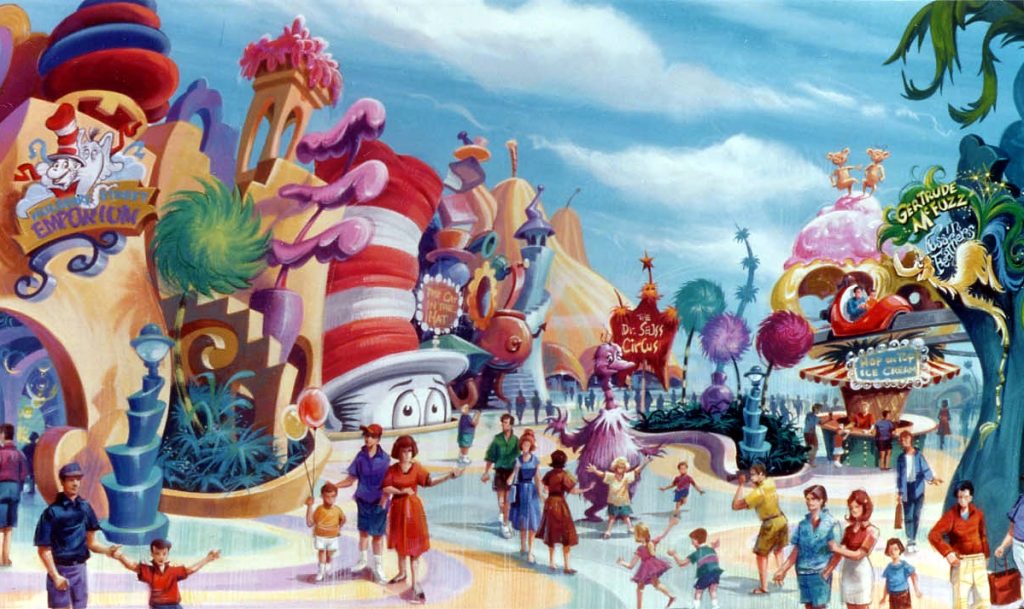
Image: Universal Studios, Source
To act as Cartoon World’s Fantasyland, with characters and stories that younger children would be familiar with, Universal was looking to create a land based on the World of Dr. Seuss. The first concepts always included a dark ride based on the Cat in the Hat, which we did end up with in the current park. Smaller flat rides like the Caro-Seuss-El carousel and One Fish, Two Fish, Red Fish, Blue Fish spinner would make it from concept to reality as well.
One concept that didn’t make it to the park as we know it, was called the Noisarium. This interactive play area was designed around sound, and would’ve acted as the post show for the Cat in the Hat ride. Here children would be able to explore a series of mysterious rooms filled with wacky larger-than-life instruments to play and interact with. Other ideas that were considered early on, but never came to be, were a boat ride based on If I Ran the Zoo, a 3D movie called Horton’s Corner, and a kiddie coaster called Grinch’s Sleigh Ride.
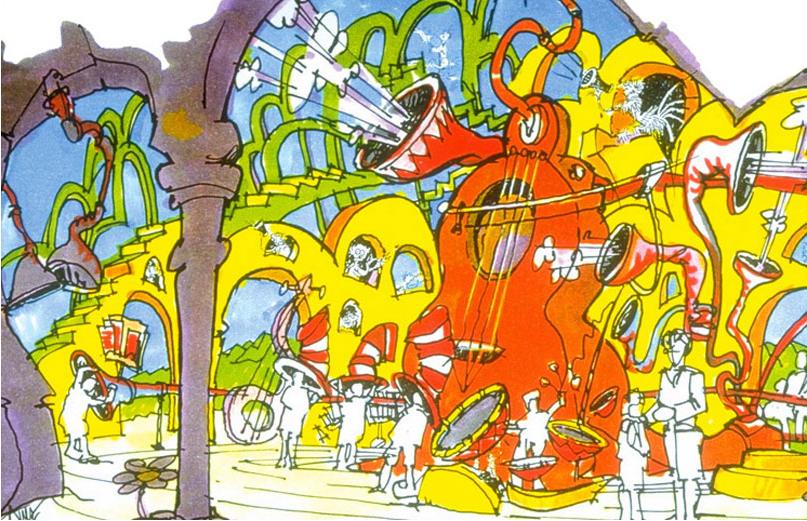
The Noisarium concept art, Image by Parkpedia
Universal had to convince Audrey Geisel to allow them to utilize the characters from Dr. Seuss in the park. She was the widow of Theodor Geisel, aka Dr. Seuss, as well as president of Dr. Seuss Enterprises. And, she was notorious for being quite protective of her late husband’s works. If Universal was unable to secure the rights to Dr. Seuss, they were prepared to shift gears and instead create attractions based on either Hanna-Barbera, which they already had the theme park rights to at the time, or Tiny Toon Adventures, a cartoon show produced by Steven Spielberg, who was a creative partner in the Universal parks.
Spielberg himself even tried reaching out to Geisel, but got no response. Eventually Universal was able to convince her literary agent to come to Orlando to see what they were working on. He called her and said, “I think you ought to take a look at this.” She felt that Universal understood her husband’s work, and that they were respecting it down to the smallest detail, so gave it her stamp of approval. She was so pleased in fact, that Geisel herself would later help Universal convince J.K. Rowling to allow them to be the ones who bring the Wizarding World into the parks.
Part 5 — Looney Tunes Land
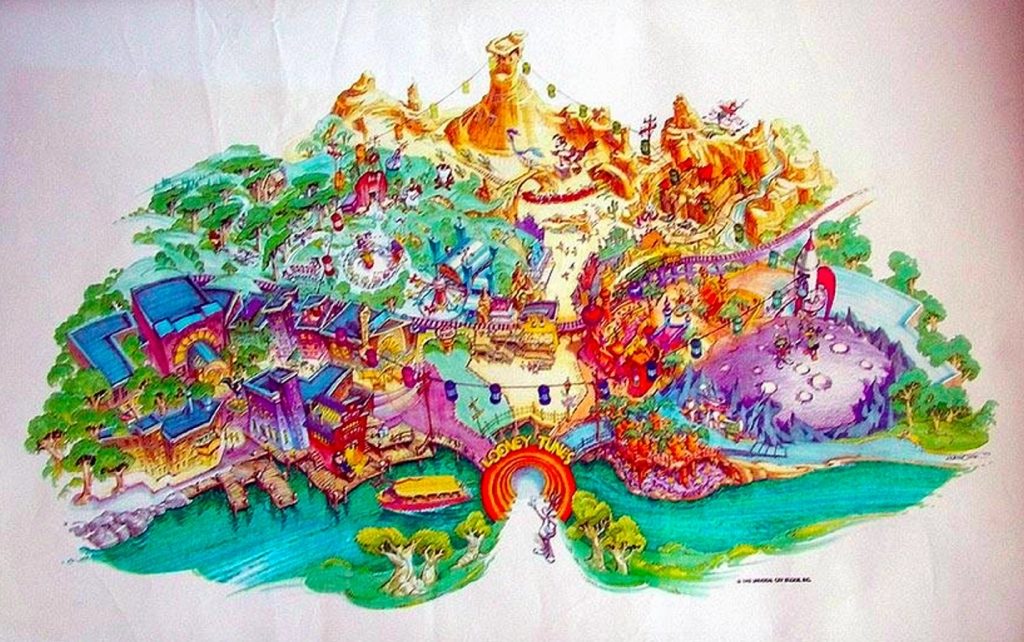
Image: The Goddard Group, Source
While creative teams were working on designing the park, executives had been negotiating with Warner Bros. over the theme park rights to their characters. Universal was reportedly offering a 6% royalty, but Warner wanted 10%. While negotiations continued, concept art for the two lands based on their properties were being presented. The first, and probably most important of these proposals, was for a land based on Looney Tunes.
Universal was banking on the preexisting popularity of characters like Bugs Bunny, Daffy Duck, and Porky Pig to add credibility to the cartoon-based park. They had their own properties at the time, like Woody Woodpecker and Fievel Mousekewitz from Spielberg’s An American Tale films, but they were nowhere near as recognizable, or entrenched in the culture, as Warner’s classic characters. Plus, the snarky attitudes of the Looney Tunes fit perfectly with Universal’s approach to the parks, as opposed to Mickey Mouse’s straitlaced persona over at Disney at the time.
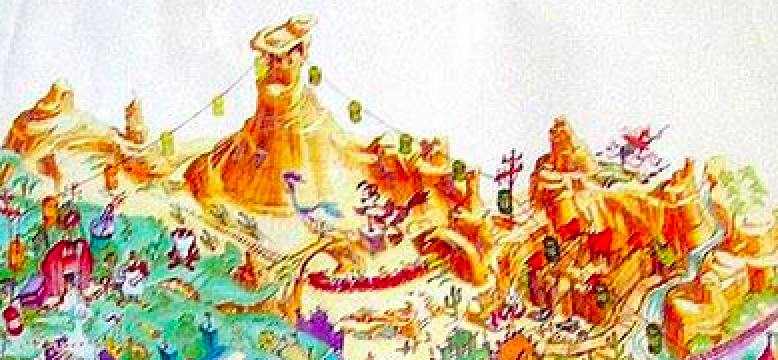
Image: The Goddard Group, Source
The land featuring these zany characters was designed to feature an entrance through the iconic opening and closing credits rings. Split into different areas, each based on a different set of characters, the land would be bursting with color and style straight from the classic cartoons. Rising in the back of the land would be a massive set-piece themed as the desert canyons from the Road Runner and Wile E. Coyote cartoons. The main attraction here would’ve been the Coyote Canyon Roller Coaster, filled with sight-gags and failed ACME product explosions around every turn.
Another coaster concept called Duck Dodgers Space Adventure would feature Daffy Duck and Marvin the Martian in an indoor roller coaster, similar to something like Space Mountain. A whole slew of dark ride concepts were dreamt up for the land as well. A flying carpet ride using the E.T. Adventure ride system based on the Ali Baba Bunny short was one. Another would be a boat ride through classic bits like the Wabbit Season scene featuring Bugs and Daffy, and other instances of Bugs outsmarting adversaries Elmer Fudd.
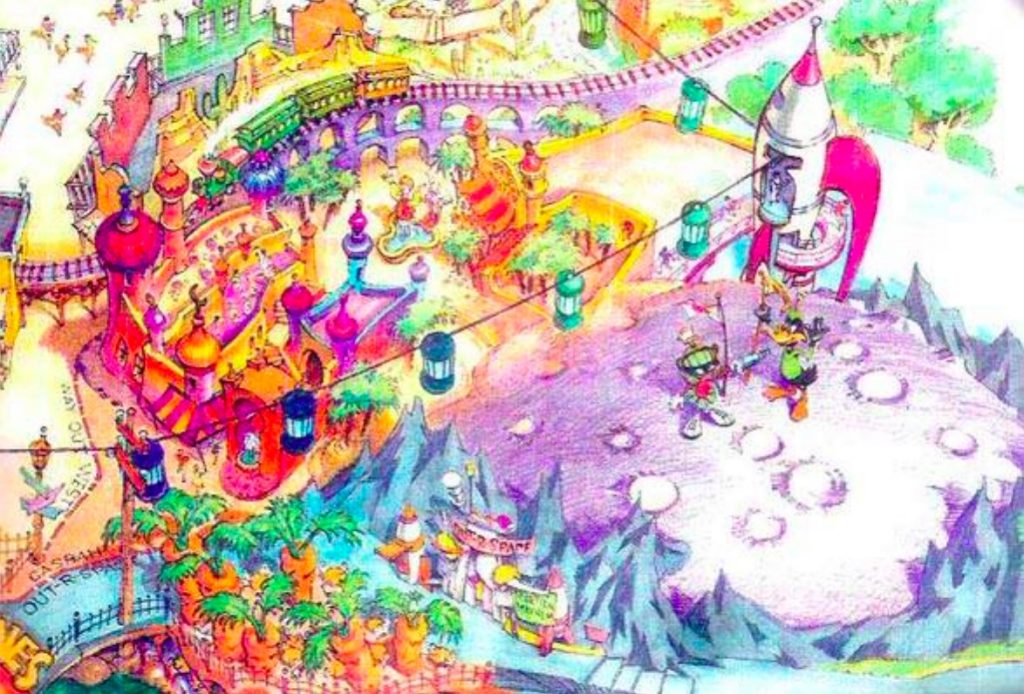
Image: The Goddard Group, Source
Proposed shows and other experiences for the land included a 3D movie where Bugs Bunny teaches you the laws of animation, a simulator ride featuring Yosemete Sam where you’re supposed to be riding horseback, and Pepe Le Pu’s Tunnel of Love featuring live entertainment. Guests would be able to glide above the entire land on the Sylvester and Tweety Skyway Ride, seated in skyway buckets shaped like bird cages. To round out the area would’ve been a mini-land for smaller kids themed to Tiny Toon Adventures, with play areas and kiddie rides—assuming they were able to secure the rights to Dr. Seuss and didn’t need Buster, Babs, and Plucky Duck to be utilized elsewhere in the park.
Part 6 — DC’s Superhero Land
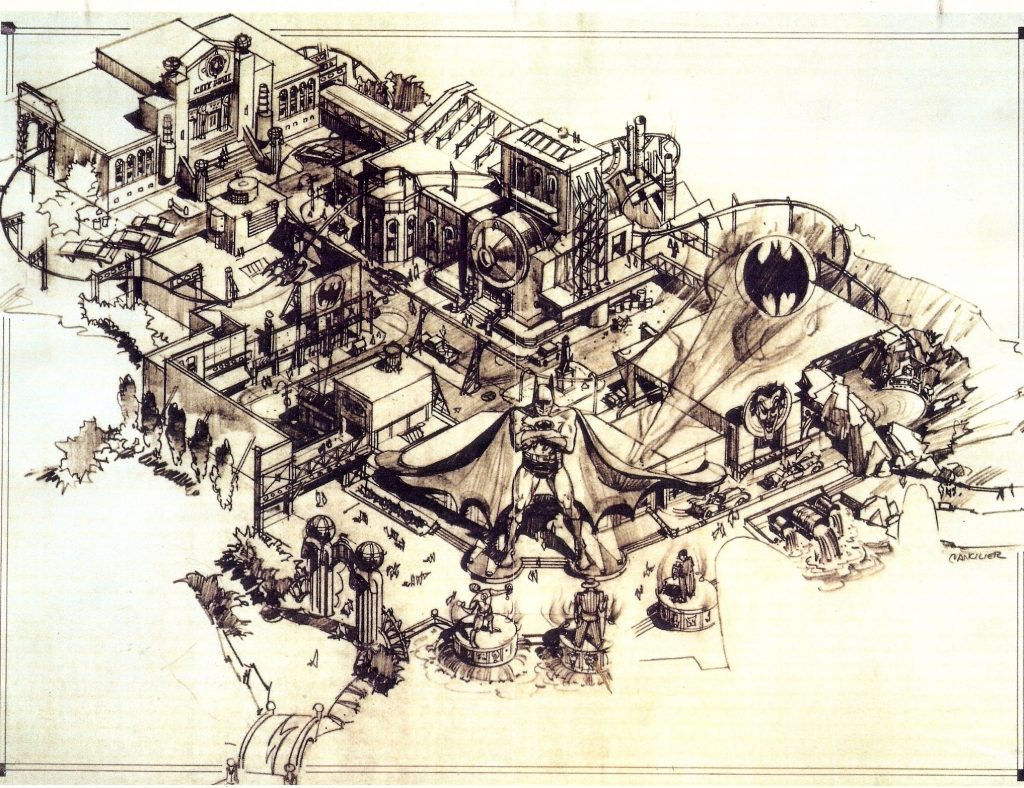
Image: The Goddard Group, Source
While the concepts were no doubt impressive, Warner Bros. was still not happy with the proposed 6% royalty deal, and countered with 8%, which was between their initial 10 and Universal’s 6. They felt it was a fair compromise between the two parties. Plus, with Batman Returns hitting theaters around this time, it seemed to some that Warner Bros. was holding all the cards, especially when you consider just how much work had already gone into designing attractions based on thing like the man of steel and caped crusader by this point.
Superhero Land was designed to be split into two separate areas, one themed as Metropolis featuring Superman themed attractions, and the other as Gotham with Batman themed rides and shows. Metropolis would be a bright and positive location, while Gotham would be dark and dangerous—not unlike how the recent Tim Burton live action films had portrayed it.
The main attraction in Metropolis would’ve been a 3D ride staring Superman and Lex Luthor. The facade for the ride was a towering skyscraper themed as the Daily Planet headquarters. Much like the current Amazing Adventures of Spider-Man ride at Islands of Adventure, this attraction would’ve had guests enter the lobby for the newspaper and then board a ride vehicle that bears some resemblance to the current incarnation’s SCOOP vehicle. Just as the Spider-Man ride of today, guests would be given 3D glasses to be worn during the ride. Unlike Spider-Man, rather than traveling around on a dark ride track, much of the Superman ride would take place on a motion simulator base in front of a screen.
The ride vehicles were themed as pods that would be docked inside of a news copter in the story. We would then take off into the sky for a nice sightseeing tour around the city. Superman would fly by and say hi, before spotting danger in the distance. We take off after him in an attempt to help cover this breaking news story for the Daily Planet. Depending on who you talk to, it sounds like one of the concepts for this attraction might have been a 130-foot free fall at the ride’s conclusion. The drop tower itself would be disguised within the massive skyscraper themed building, and much of the attraction would involve a motion simulator themed as a helicopter, quietly raising our ride vehicle up 13 stories in preparation for the climatic drop at the end.

Stunt Show Concept by The Goddard Group, Source
On the Gotham side of the land a whole slew of concepts were pitched. A few shows were designed including a 3D movie in The Gotham Opera House and a concept for a VR show that was probably a little ahead of its time. A massive stunt-filled lagoon show called The Batman & Robin Action Adventure Spectacular would’ve likely been similar to the then running Dynamite Nights Stunt Spectacular over at Universal Studios Florida.
One of the more unique concepts was called the Joker’s Madhouse. Entering the queue through the Joker’s mouth, guests would board Jokester Roadster ride cars, which would travel along a wild-mouse type coaster track. The ride would be set up like an elaborate dark ride, but with dramatic turns and sudden drops. It would culminate with a false ending where the track appears to end up ahead. This would use a mirror gag that would hide the real track and a sudden drop. This ride’s post-show would allow guests to walk through a series of fun house style rooms featuring many of Batman’s most popular villains.
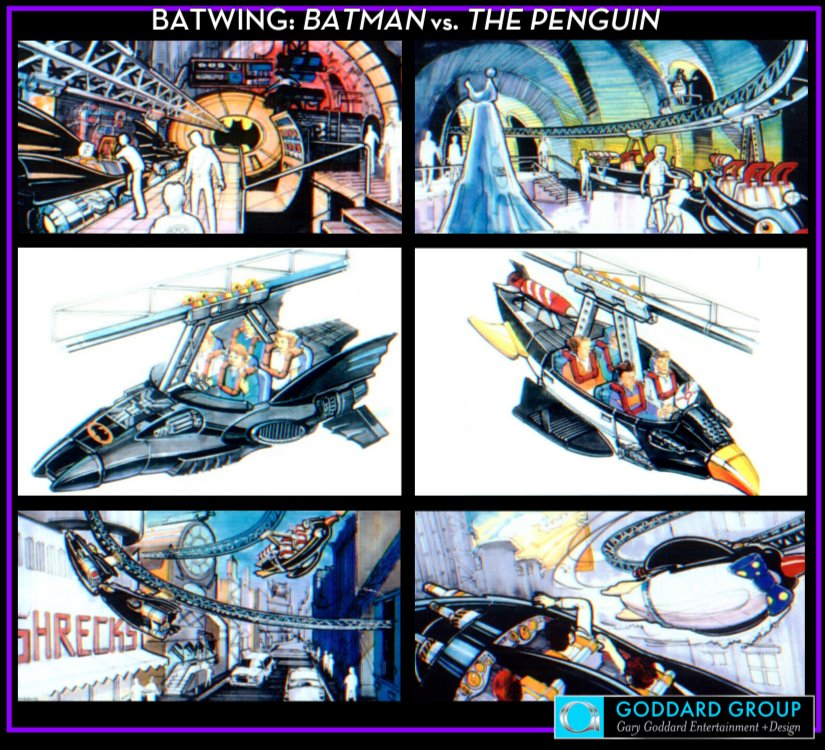
Bat Wing Concept by The Goddard Group, Source
A second coaster was designed for Gotham City as well. While it started out as another Joker-based attraction, it was ultimately redesigned to feature the Penguin, a character the designers felt would be made popular by the recent theatrical release of Batman Returns. This dueling coaster attraction would allow guests to choose to either ride in Batman’s BatWing Flyer or The Penguin’s PengWing Fighter. The BatWing would load from the Batcave, while the PengWing would load from the Penguin’s subterranean lair, as seen in the latest film. With near misses between the two coaster trains meant to simulate a mid-air dogfight, the track would travel through three separate show buildings each with their own settings and Batman villains in an epic experience.
Part 7 — Change of Plans
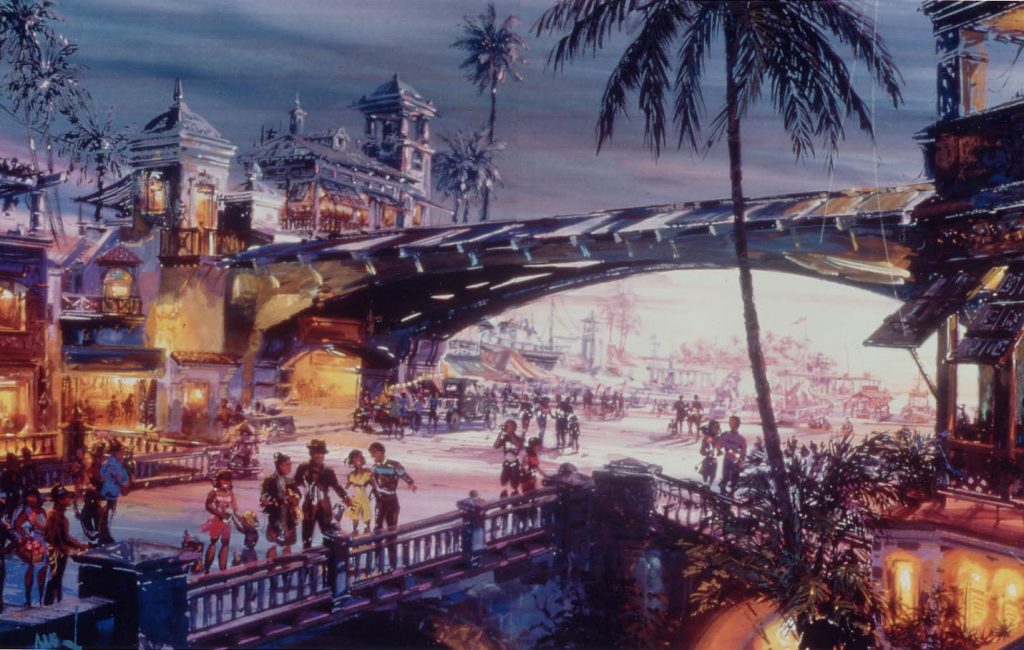
Image: Universal Studios, Source
Refusing to budge, and not interested in Warner’s offer of an 8% royalty, the design team pleaded with Sid Sheinberg, the then head of MCA, which was Universal’s parent company at the time, to at least consider offering 7% to Warner. So much work had gone into their designs over the previous two years. But the deal officially died in late 1993 when Sheinberg reportedly told the executives at Warner Bros, and I quote: “we don’t need your [expletive] characters.”
By December of 1993 it was decided to shelve Cartoon World. The company decided to continue on with the second gate, so the plans were re-worked. The Jurassic Park ride concept that was being designed for Universal Studios Florida was moved to this new park. It was suggested that instead of cartoons, the new park could be based on legends. Universal Monsters were considered at one point, but eventually they went with a land based on historical myths called The Lost Continent. And Marvel was approached as a way to salvage some of the DC ride concepts. All of these new ideas were added to the existing plans for Dr. Seuss and Toon Lagoon attractions they still had the rights to. Many of this park’s new lands seemed to include a lagoon of some sort so the park became known as Islands of Adventure. Despite the shake up, it opened only one year later than they had originally planned.
When it comes to the world of theme parks, no idea is ever really gone. In 2019 Universal announced plans for a third theme park in Orlando. This new park would again re-visit the idea of a hub and spoke design. Once again it appears as though the company is ready to go to toe to toe with the mouse down the street, and attempt to capture even more of your family’s vacation days the next time you visit Orlando.
Hope you enjoyed this look back at how the development for Islands of Adventure started out! Be sure to check out the video version of this article here. And you can see our previous story about never-built Jurassic Park attractions here. Subscribe to the news feed to never miss an update, or enter your email address below. Main Image: Source | Other Images as Captioned
Subscribe to Receive Email Updates
![]() Consider supporting us on Patreon for as little as $1/month. All patrons receive behind the scenes posts and exclusive podcasts. Learn More
Consider supporting us on Patreon for as little as $1/month. All patrons receive behind the scenes posts and exclusive podcasts. Learn More

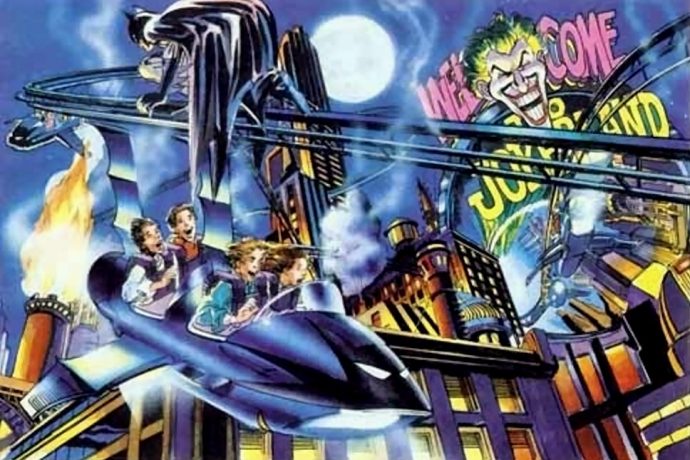
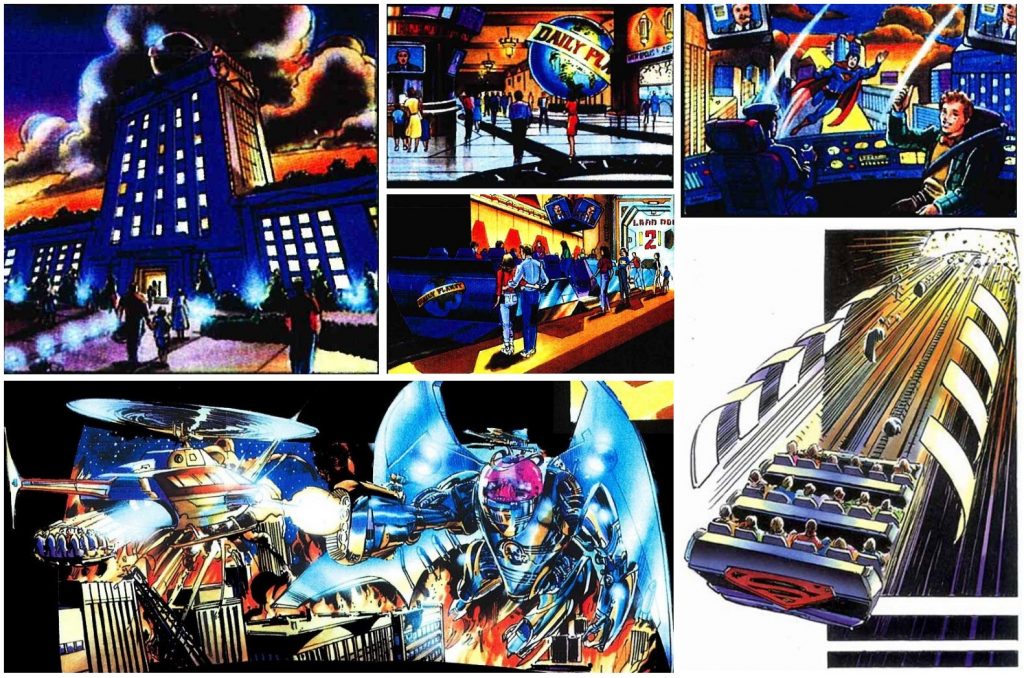
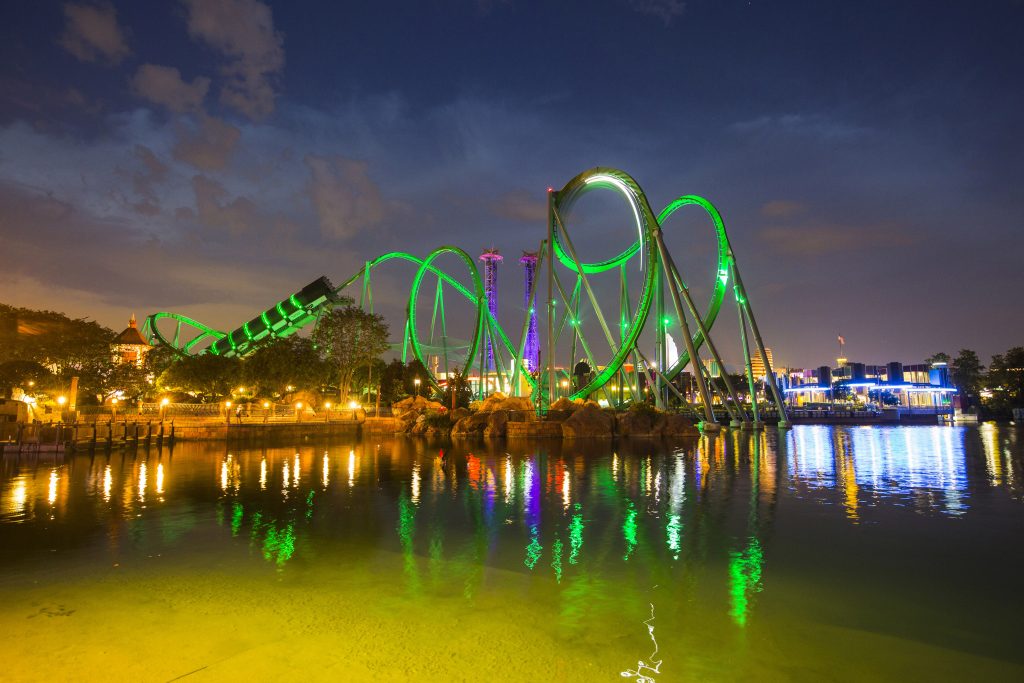
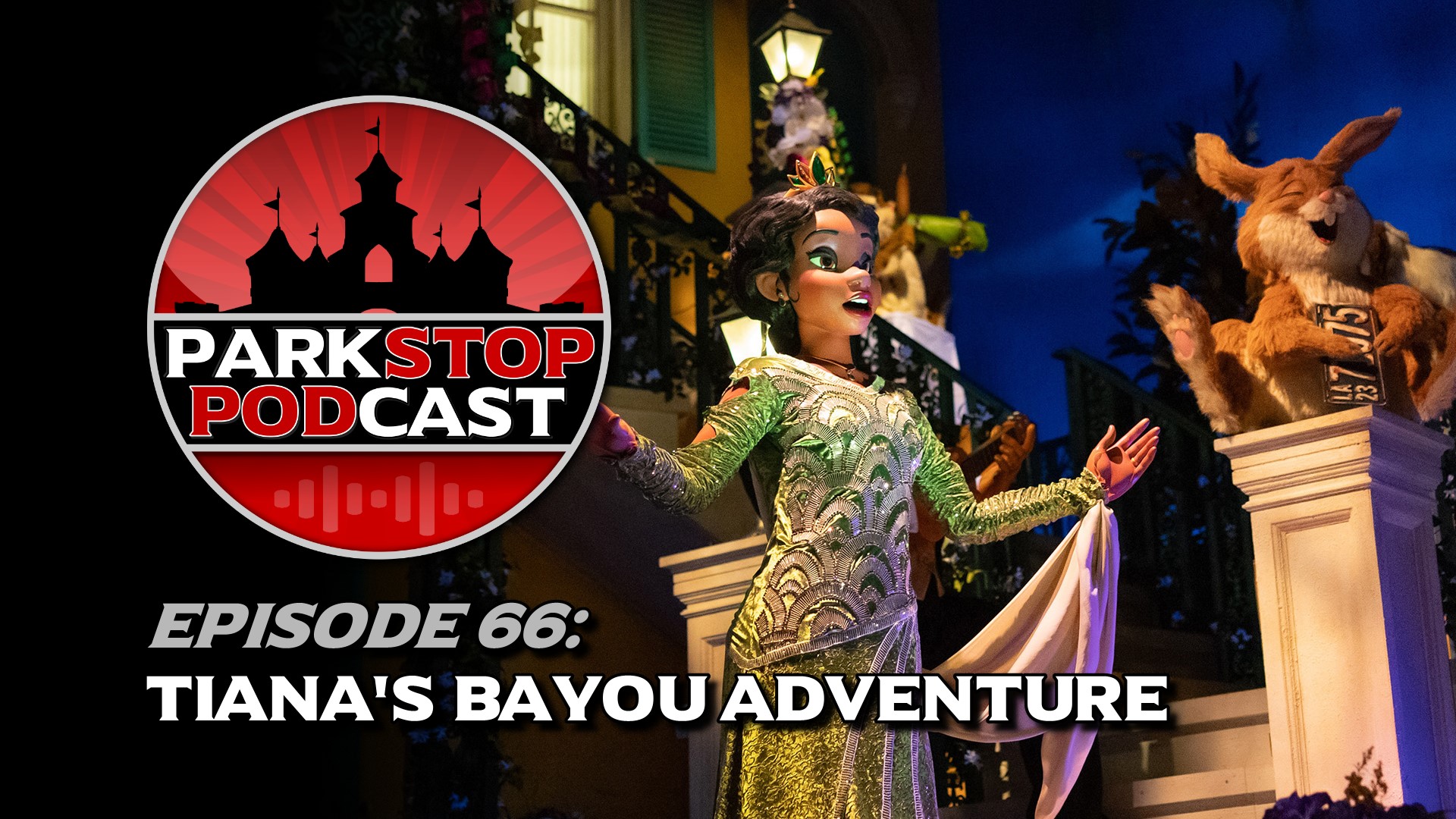
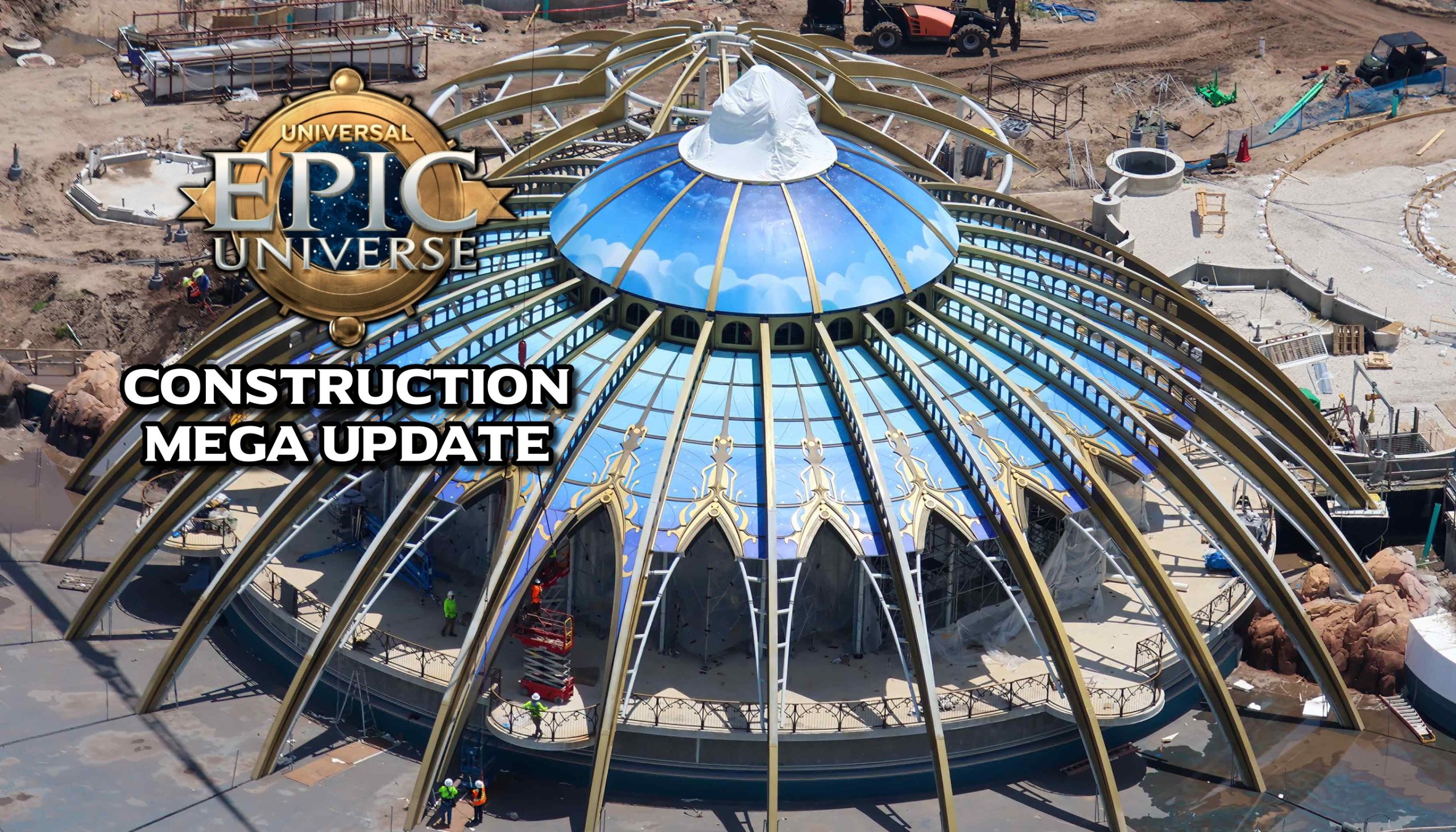
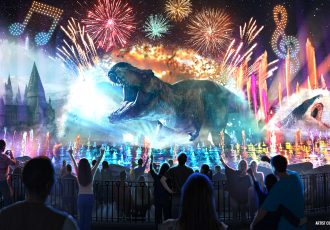
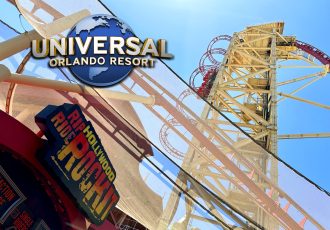
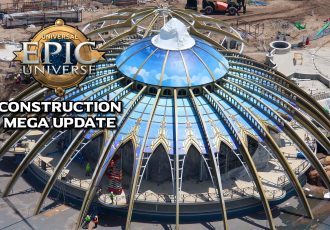

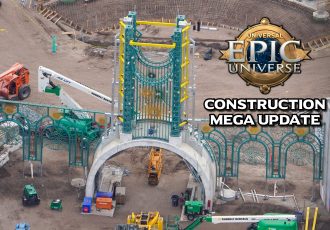
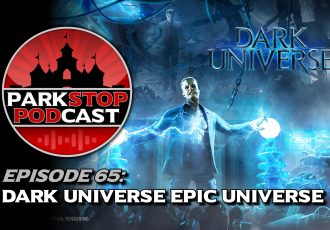

6 Comments
Dianne
Having been a member of the Islands of Adventure opening crew I can attest to the blood, sweat and tears that went to the opening of the park! Miss being part of the crew!
Brian Onis
I loved some of the concepts. I think DC is alive and well in Six Flags so no need for Universal’s take. I would rather have Marvel but I bet their Executives hate writing checks to Disney every month.
CJBrownLV
In the end? Warner Bros’ intellectual property (DC, Looney Tunes) ended up at Six Flags Theme Parks …… so now you have to ask who won that fight over licensing % – Universal, or Warner Bros? (and it took Harry Potter for both to finally form a partnership decades later.)🤔